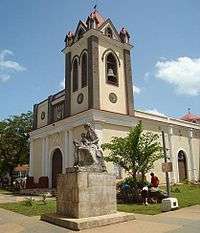Artemisa
| Artemisa | |
|---|---|
| Municipality | |
|
The Martyrs Mausoleum (Mausoleo de los Mártires) | |
.png) Artemisa municipality (red) within Artemisa Province (yellow) and Cuba | |
 Location of Artemisa in Cuba | |
| Coordinates: 22°48′49″N 82°45′48″W / 22.81361°N 82.76333°WCoordinates: 22°48′49″N 82°45′48″W / 22.81361°N 82.76333°W | |
| Country |
|
| Province | Artemisa |
| Founded | 1818 |
| Incorporated | 1976 |
| Founded by | Francisco de Arango y Parreño |
| Area[1] | |
| • Total | 690 km2 (270 sq mi) |
| Elevation | 50 m (160 ft) |
| Population (2004)[2] | |
| • Total | 81,209 |
| • Density | 117.7/km2 (305/sq mi) |
| Demonym(s) | Artemiseño, -a |
| Time zone | EST (UTC-5) |
| Area code(s) | +53-47 |
| Climate | Aw |
Artemisa (Spanish pronunciation: [aɾteˈmisa]) is a municipality and city in Cuba, formerly part of La Habana Province. According to a law approved by the Cuban National Assembly in August 2010, Artemisa became the capital city of the newly formed Artemisa Province, which comprises 8 municipalities of the former La Habana Province and 3 from Pinar del Río.[3]
History
The origin of the name of Artemisa is uncertain. It has been argued to have originated from the Greek goddess Artemis (Diana, in the Roman version) or that it refers to the name of Ragweed in Spanish, Artemisia (Ambrosia artemisifolia), abundant at the time.
Artemisa was an important source of fighters supporting Fidel Castro's Revolution during the attack on "Cuartel Moncada" in Santiago de Cuba (1953) and Sierra Maestra Guerrilla (1956–1959). The Martyrs Mausoleum (Mausoleo de los Mártires) in Artemisa is a National Monument of Cuba.[4]
Artemisa belonged to Pinar del Río Province until 1970.
Geography
The municipality is divided into the barrios of Las Cañas, Lavandero (El Pilar), Cayajabos, Lincoln (Andorra), Pijirigua, Puerta de la Güira, Las Mangas, Neptuno and El Corojal.
Demographics
In 2004, the municipality of Artemisa had a population of 81,209.[2] With a total area of 690 km2 (270 sq mi),[1] it has a population density of 117.7/km2 (305/sq mi).
Economy
Artemisa is widely known among Artemiseños by the name Jardín de Cuba (Garden of Cuba). Its ferric red soil is also an outstanding feature, and provides great fertility to the area, which produces banana, tobacco, sugar cane, and minor fruits. Due to the color of the soil, Artemisa is known as Villa Roja (Red Village).
Main sights

Places of historical importance include the Cafetal Angerona (named after Angerona, the goddess of silence and fertility, and protector of Rome), which is currently in ruins. Its remains evoke a period of great abundance, business development, love affairs, and slavery. The cafetal belonged to the German entrepreneur Cornelio Souchay who fell in love with the black Haitian, Úrsula Lambert. The couple lived their romance in secret due to the taboos of the period.
The Hotel Campoamor, built by Asturiano Fernando González-Campoamor, has played an important role since it was finished in 1911. Many important figures visited the place, including Rita Longa, Ernest Hemingway, Juan Marinello, Gabriela Mistral, and Ignacio Villa "Bola de Nieve." Centrales azucareros (Sugar mills) Pilar and Lavandero are landmarks of the city, as well as the mansion of sugar magnate, Julio Lobo.
Artemisa's patron saint is Saint Mark the Evangelist. The church of Artemisa is located in The Park (el Parque). The building was renovated due to efforts made by Father Antonio Rodriguez Dias, the hard work and cooperation of many Artemiseños, and generous monetary donations from German brethren.
Other sites include the Artemisa Municipal Museum.
Personalities
Important personalities in the history of Cuba were born or lived in Artemisa. Among them Magdalena Peñaredonda, a poet and journalist, appointed as captain of rebel forces during the war of independence, Father Guillermo González Arocha, born in Regla, but whose significant contribution to the independence of Cuba was carried out while a priest in Artemisa, is considered an adopted son of the city. This priest also founded a school and had the cemetery of the city built.
See also
References
- 1 2 Statoids (July 2003). "Municipios of Cuba". Archived from the original on 12 October 2007. Retrieved 2007-10-07.
- 1 2 Atenas.cu (2004). "2004 Population trends, by Province and Municipality" (in Spanish). Archived from the original on 2007-09-27. Retrieved 2007-10-07.
- ↑ http://www.cubadebate.cu/noticias/2010/06/07/cuba-tiene-dos-nuevas-provincias-artemisa-y-mayabeque/
- ↑ National Council for Cultural Heritage. "National Monuments in Cuba" (in Spanish). Retrieved 2007-10-09.
External links
| Wikivoyage has a travel guide for Artemisa. |
![]() Media related to Artemisa at Wikimedia Commons
Media related to Artemisa at Wikimedia Commons
